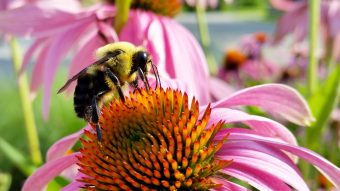Bumblebee colonies fare better in villages and cities than in fields, research has revealed.

Bumblebees are important pollinators, but face threats including habitat loss, climate change, pesticide and fungicide use and parasites. Now researchers say that bumblebee colonies in urban areas not only produce more offspring than those on agricultural land, but have more food stores, fewer invasions from parasitic “cuckoo” bumblebees, and survive for longer.
“[The study] is not saying that cities are necessarily the ideal habitat for bees, it is just that they are doing better in the cities than in the countryside,” said Ash Samuelson, a doctoral student and first author of the research from Royal Holloway, University of London.
While researchers have previously found a greater variety of pollinator species in urban settings, Samuelson says the latest study goes further, revealing that it is not simply that bumblebees make a flying visit to urban locations, but that populations are stronger there.
Writing in the journal Proceedings of the Royal Society B, Samuelson and colleagues describe how they collected native queen bees from Windsor Great Park in the spring and put them into nest boxes to lay their first batch of eggs.
The resulting young colonies were then placed at 38 sites between central London and Basingstoke.
The queen in a colony, notes Samuelson, can lay eggs that give rise to more worker bees, which themselves cannot reproduce, or – once the colony reaches a certain size and strength – lay eggs that hatch bees that can reproduce: either females that will go on to become queens, known as gynes, or males.
The team visited each colony once a week at night – when bees don’t fly – to count the number of worker bees, see whether the queen was alive, take stock of nectar and pollen stores and take note of – and remove – any cuckoo bumblebees.
They also counted and removed any males or gynes – mimicking their natural tendency to leave the nest – and totted up the total number during the study.
This continued until the colony petered out – a process that took a maximum of 10 weeks.
The team then examined the 38 sites, each with a 500m radius, using aerial photographs and found that they fell into one of three groups based on various criteria of urban development, with five “agricultural”, 16 “village” and 17 labelled as “city” locations.
The team’s analysis reveals that the type of land was linked to the success of the colony, with similar results for cities and villages, and worse outcomes for agricultural settings.
Among the results, the team found that city colonies were significantly more likely to give rise to males and gynes than agricultural ones, with only one in the latter setting giving rise to such “reproductive” bees. What’s more, both village and city colonies had a markedly greater number of these bees over the course of the study than agricultural colonies, as well as more worker bees at their peak.
The team’s analysis reveals that the type of land was linked to the success of the colony, with similar results for cities and villages, and worse outcomes for agricultural settings.
Among the results, the team found that city colonies were significantly more likely to give rise to males and gynes than agricultural ones, with only one in the latter setting giving rise to such “reproductive” bees. What’s more, both village and city colonies had a markedly greater number of these bees over the course of the study than agricultural colonies, as well as more worker bees at their peak.
The team also found that agricultural colonies were more often invaded by cuckoo bumblebees – possibly, the team say, because air pollution might mask chemical signals given off by colonies
While the study reveals that the urban boon for bees is, in part, linked to fewer invasions by cuckoo bees, Samuelson said the greater availability and variety of flowers in gardens and parks could also be a driver – although the analysis did not provide clear evidence that the proportion of flower-rich habitat had an impact.
“Because bees are more likely to potentially be exposed to pesticides in the agricultural areas, maybe this is having an effect,” she added.
Dr Mick Hanley, an expert in plant-animal interactions from the University of Plymouth who was not involved in the study, said it is likely many factors contribute to bumblebees are thriving in urban settings, adding that the cultivation of flowering plants throughout the year in villages and cities could also help bumblebees, compared to fields where, if they are present at all, flowering periods are short-lived.
“We have always suspected that many pollinators, not just bees, are doing better in urban environments, but this actually gets at the nub, for one species, as to how and why they might be performing better biologically,” he said.
Jane Memmott, professor of ecology at the University of Bristol who was not involved in the study, urged individuals to give bumblebees a helping hand.
“This paper provides definitive evidence of the value of urban areas to bumblebees,” she said. “Moreover, helping urban pollinators is the sort of conservation project that everyone can help with – if you have a garden, balcony or even just a sunny doorstep, you can grow plants for both bees and people to enjoy”.
Source: Guardian

